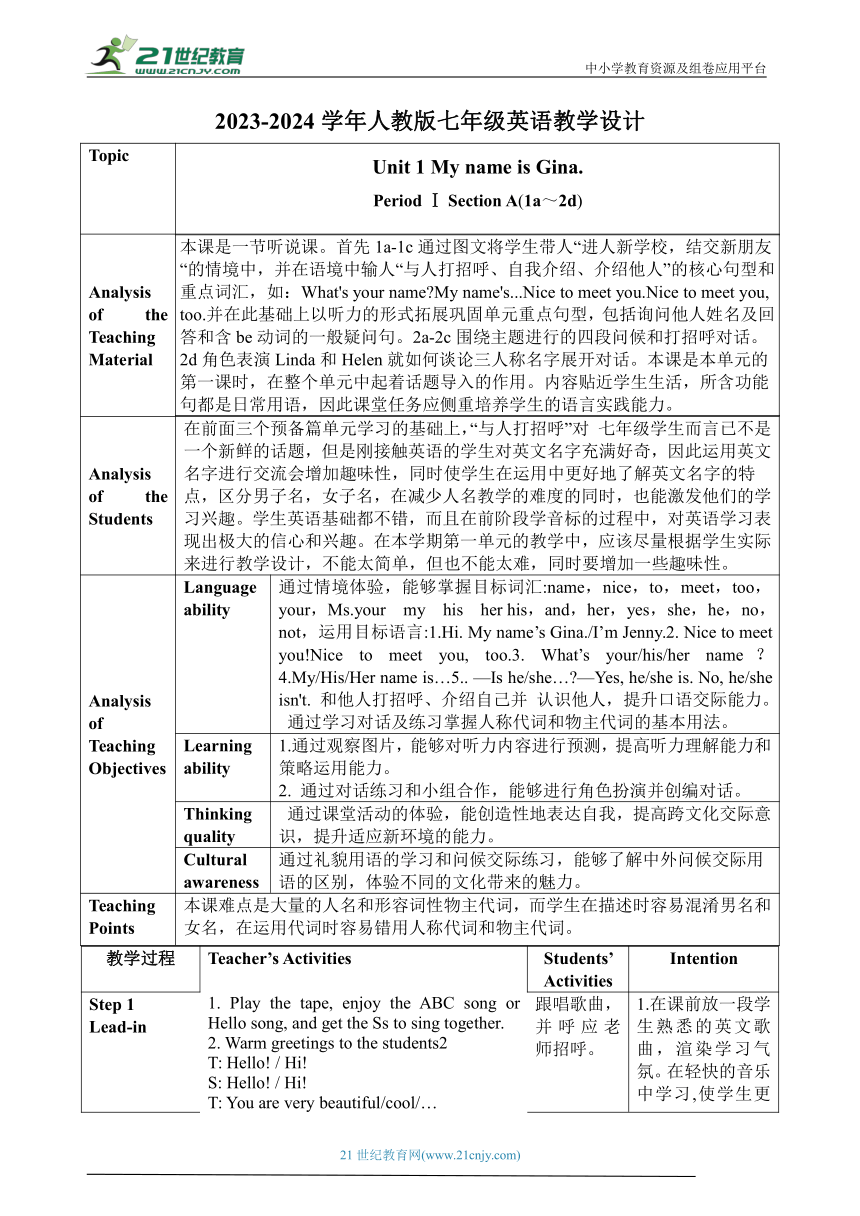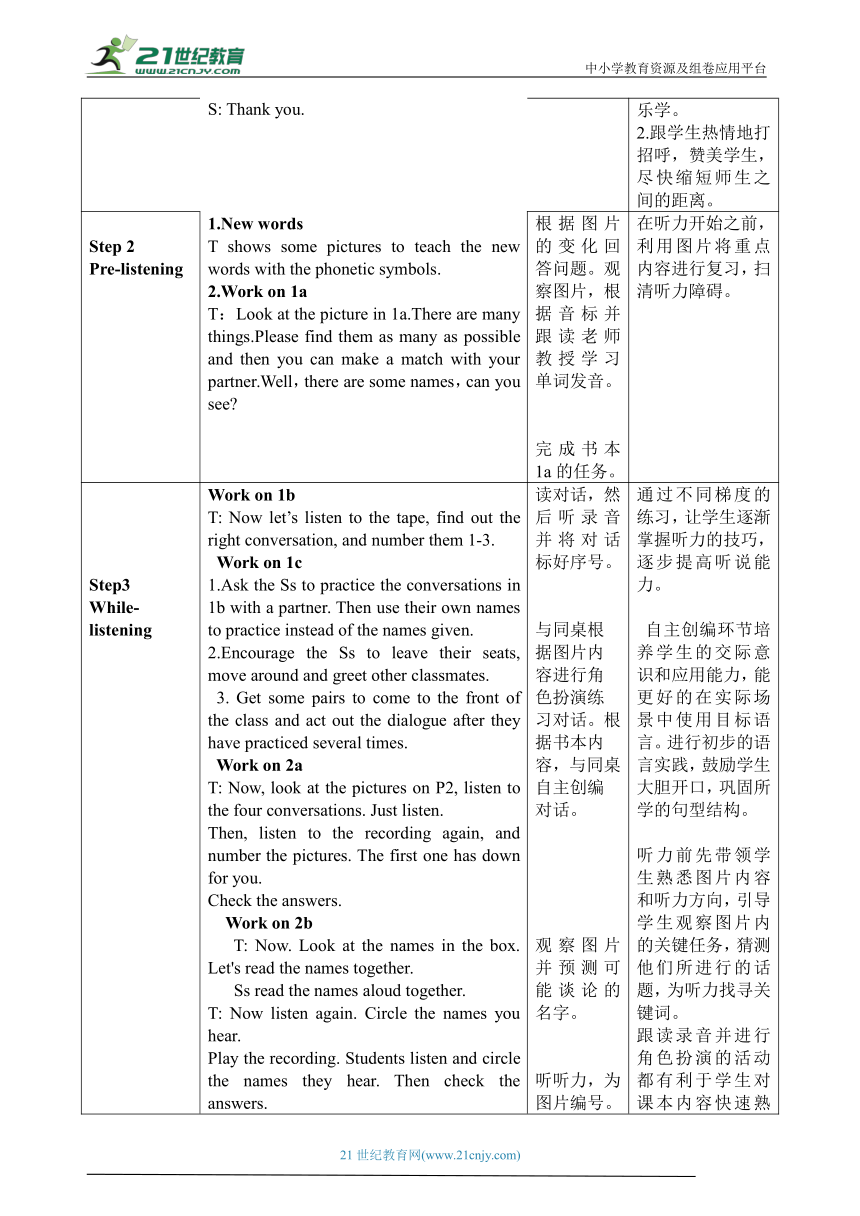【核心素养目标】Unit 1 My name is Gina.SectionA (1a--2d)表格式教学设计 人教版英语七年级上册
文档属性
| 名称 | 【核心素养目标】Unit 1 My name is Gina.SectionA (1a--2d)表格式教学设计 人教版英语七年级上册 |

|
|
| 格式 | doc | ||
| 文件大小 | 205.1KB | ||
| 资源类型 | 试卷 | ||
| 版本资源 | 人教新目标(Go for it)版 | ||
| 科目 | 英语 | ||
| 更新时间 | 2023-09-27 23:04:09 | ||
图片预览


文档简介
中小学教育资源及组卷应用平台
2023-2024学年人教版七年级英语教学设计
Topic Unit 1 My name is Gina.Period Ⅰ Section A(1a~2d)
Analysis of the Teaching Material 本课是一节听说课。首先1a-1c通过图文将学生带人“进人新学校,结交新朋友“的情境中,并在语境中输人“与人打招呼、自我介绍、介绍他人”的核心句型和重点词汇,如:What's your name My name's...Nice to meet you.Nice to meet you, too.并在此基础上以听力的形式拓展巩固单元重点句型,包括询问他人姓名及回答和含be动词的一般疑问句。2a-2c围绕主题进行的四段问候和打招呼对话。2d角色表演Linda和Helen就如何谈论三人称名字展开对话。本课是本单元的第一课时,在整个单元中起着话题导入的作用。内容贴近学生生活,所含功能句都是日常用语,因此课堂任务应侧重培养学生的语言实践能力。
Analysis of the Students 在前面三个预备篇单元学习的基础上,“与人打招呼”对
七年级学生而言已不是一个新鲜的话题,但是刚接触英语的学生对英文名字充满好奇,因此运用英文名字进行交流会增加趣味性,同时使学生在运用中更好地了解英文名字的特点,区分男子名,女子名,在减少人名教学的难度的同时,也能激发他们的学习兴趣。学生英语基础都不错,而且在前阶段学音标的过程中,对英语学习表现出极大的信心和兴趣。在本学期第一单元的教学中,应该尽量根据学生实际来进行教学设计,不能太简单,但也不能太难,同时要增加一些趣味性。
Analysis of Teaching Objectives Language ability 通过情境体验,能够掌握目标词汇:name,nice,to,meet,too,your,Ms.your my his her his,and,her,yes,she,he,no,not,运用目标语言:1.Hi. My name’s Gina./I’m Jenny.2. Nice to meet you!Nice to meet you, too.3. What’s your/his/her name?4.My/His/Her name is…5.. —Is he/she… —Yes, he/she is. No, he/she isn't. 和他人打招呼、介绍自己并
认识他人,提升口语交际能力。
通过学习对话及练习掌握人称代词和物主代词的基本用法。
Learningability 1.通过观察图片,能够对听力内容进行预测,提高听力理解能力和策略运用能力。2.
通过对话练习和小组合作,能够进行角色扮演并创编对话。
Thinking quality
通过课堂活动的体验,能创造性地表达自我,提高跨文化交际意识,提升适应新环境的能力。
Cultural awareness 通过礼貌用语的学习和问候交际练习,能够了解中外问候交际用语的区别,体验不同的文化带来的魅力。
Teaching Points 本课难点是大量的人名和形容词性物主代词,而学生在描述时容易混淆男名和女名,在运用代词时容易错用人称代词和物主代词。
教学过程 Teacher’s Activities Students’ Activities Intention
Step 1Lead-in 1. Play the tape, enjoy the ABC song or Hello song, and get the Ss to sing together.2. Warm greetings to the students2 T: Hello! / Hi! S: Hello! / Hi! T: You are very beautiful/cool/…S: Thank you. 跟唱歌曲,并呼应老师招呼。 1.在课前放一段学生熟悉的英文歌曲,渲染学习气氛。在轻快的音乐中学习,使学生更乐学。 2.跟学生热情地打招呼,赞美学生,尽快缩短师生之间的距离。
Step 2Pre-listening 1.New wordsT shows some pictures to teach the new words with the phonetic symbols.2.Work on 1aT:Look at the picture in 1a.There are many things.Please find them as many as possible and then you can make a match with your partner.Well,there are some names,can you see 根据图片的变化回答问题。观察图片,根据音标并跟读老师教授学习单词发音。完成书本1a的任务。 在听力开始之前,利用图片将重点内容进行复习,扫清听力障碍。
Step3While-listening Work on 1bT: Now let’s listen to the tape, find out the right conversation, and number them 1-3. Work on 1c1.Ask the Ss to practice the conversations in 1b with a partner. Then use their own names to practice instead of the names given.2.Encourage the Ss to leave their seats, move around and greet other classmates. 3. Get some pairs to come to the front of the class and act out the dialogue after they have practiced several times. Work on 2aT: Now, look at the pictures on P2, listen to the four conversations. Just listen. Then, listen to the recording again, and number the pictures. The first one has down for you.Check the answers. Work on 2b T: Now. Look at the names in the box. Let's read the names together. Ss read the names aloud together. T: Now listen again. Circle the names you hear. Play the recording. Students listen and circle the names they hear. Then check the answers. 读对话,然后听录音并将对话标好序号。 与同桌根据图片内容进行角色扮演练习对话。根据书本内容,与同桌自主创编对话。观察图片并预测可能谈论的名字。听听力,为图片编号。再听一遍,圈出所听到名字。听录音并跟读对话材料。 通过不同梯度的练习,让学生逐渐掌握听力的技巧,逐步提高听说能力。 自主创编环节培养学生的交际意识和应用能力,能更好的在实际场景中使用目标语言。进行初步的语言实践,鼓励学生大胆开口,巩固所学的句型结构。听力前先带领学生熟悉图片内容和听力方向,引导学生观察图片内的关键任务,猜测他们所进行的话题,为听力找寻关键词。跟读录音并进行角色扮演的活动都有利于学生对课本内容快速熟悉并掌握,了解其在具体语境中的应用。
Step4Post-listening Work on 2c1. Suppose you are new students in No. 1 Middle School. You are from different countries. You meet for the first time. Make up a dialogue in pairs. Make a model dialogue with a student. Other students should listen carefully. Let all the students work in pairs. Practice the dialogue. Then ask some pairs to act out their dialogues.Work on 2d1. Ask Ss to look at the picture in 2d. Then Ss read the dialogue by themselves and try to find out what their names are. 2. Divide the Ss into groups of four. Let them practice the dialogue in their group. 4. Then ask some groups to act out their dialogue in front of class. 5. 评价:(让学生们对自己的表现及语言表达能力进行自我评价,在小组内评价,然后进行评出最优秀的小组。并鼓励学生们下一次争取做最优秀的小组及个人。) 补充对话进行角色扮演。与同桌用2a部分的对话模板创编对话。读对话并回答问题。读对话找出表达喜好的句型。跟着录音读一遍2d,标注语调变化和重点词组。与同桌角色扮演2d内容。 通过之前句型的学习,为2c部分的练习打好的基础,要求学生以小组的形式进行问答的难度降低。进行初步的语言实践,鼓励学生大胆开口,巩固所学的句型结构。让学生带着问题阅读对话,帮助学生更好地理解对话内容。模仿语音语调,并以表演的形式,让学生将所学内容进行输出,学练结合。
Step 5Language Points Explanation T explains knowledge points.1. My name’s Gina. 我的名字是吉娜。My name is. . . 意为“我的名字是……”, 是自我介绍的句型, 也可以说“I’m Gina. ”。My name’s是My name is的缩写形式。2.What’s your name 是询问对方姓名的特殊疑问句, what’s是what is的缩写。有时句末也可以加上please, 以示客气、礼貌, 读时用降调。 3. Nice to meet you! 很高兴见到你! Nice to meet you! 是双方首次见面或久别重逢时的问候语,相当于Glad to meet you! 将知识点做好笔记。 将本课重点汇总系统的进行讲解和分析,结合典例,帮助学生形成语言体系。
Step6Exercises 补全对话。AA:Hello, what’s your name B:My name is Gina. And you A:I am Tom.B:Nice to meet you.A: Nice to meet you, too .BA:Good afternoon, Mike!B:Good afternoon . Tony! How are you A:Fine,thanks. Look! What’s this in English B:It’s a clock.A:Spell it,please.B:C-L-O-C-K. 完成课堂练习。 让学生在课上练习消化知识点,及时操练重点知识点和目标语言,让教师把握学情。
Step 7Summary Summarize the key content in this lesson. 跟随老师一起进行内容总结。 强化巩固本课所学内容。
Step 8 Homework 1.Remember the words and phrases in this lesson.2.Make a conversation according to the conversation 2d. 将家庭作业做好记录。 检查学习效果,加深对知识的理解和记忆。
Blackboard Design Unit 1 My name's Gina.Period I Section A(1a~2d)Words your my his her his,and,her,yes,she,he,no,notKey sentences—What's his name?—His name's Eric./He's Eric.—What's her name?—Her name's Mary./She's Mary.—Are you Helen?—Yes,I am./No,I'm not.—Is he Jack?—Yes,he is./No,he isn't. 缩写形式:What’s = What is I’m=I am name’s=name is
Teaching Reflection: 教学反思本节课的设计体现了任务型教学的特点,整个任务链的设计均以学生的兴趣为主,由易至难,逐层递进,逐步完成各个任务,使学生在愉快地完成每一个任务的同时,体会到学习英语的乐趣,并使每一位学生都参与到活动中,都有所提高。所学功能句都是日常用语,因此课堂任务侧重培养了学生的语言实践能力,避免了死记硬背。在听力活动中,老师注重了听前预测方法的指导,同时能够注重自主学习和合作
学习相结合,充分发挥学生的学习能动性。
21世纪教育网 www.21cnjy.com 精品试卷·第 2 页 (共 2 页)
HYPERLINK "http://www.21cnjy.com/" 21世纪教育网(www.21cnjy.com)
2023-2024学年人教版七年级英语教学设计
Topic Unit 1 My name is Gina.Period Ⅰ Section A(1a~2d)
Analysis of the Teaching Material 本课是一节听说课。首先1a-1c通过图文将学生带人“进人新学校,结交新朋友“的情境中,并在语境中输人“与人打招呼、自我介绍、介绍他人”的核心句型和重点词汇,如:What's your name My name's...Nice to meet you.Nice to meet you, too.并在此基础上以听力的形式拓展巩固单元重点句型,包括询问他人姓名及回答和含be动词的一般疑问句。2a-2c围绕主题进行的四段问候和打招呼对话。2d角色表演Linda和Helen就如何谈论三人称名字展开对话。本课是本单元的第一课时,在整个单元中起着话题导入的作用。内容贴近学生生活,所含功能句都是日常用语,因此课堂任务应侧重培养学生的语言实践能力。
Analysis of the Students 在前面三个预备篇单元学习的基础上,“与人打招呼”对
七年级学生而言已不是一个新鲜的话题,但是刚接触英语的学生对英文名字充满好奇,因此运用英文名字进行交流会增加趣味性,同时使学生在运用中更好地了解英文名字的特点,区分男子名,女子名,在减少人名教学的难度的同时,也能激发他们的学习兴趣。学生英语基础都不错,而且在前阶段学音标的过程中,对英语学习表现出极大的信心和兴趣。在本学期第一单元的教学中,应该尽量根据学生实际来进行教学设计,不能太简单,但也不能太难,同时要增加一些趣味性。
Analysis of Teaching Objectives Language ability 通过情境体验,能够掌握目标词汇:name,nice,to,meet,too,your,Ms.your my his her his,and,her,yes,she,he,no,not,运用目标语言:1.Hi. My name’s Gina./I’m Jenny.2. Nice to meet you!Nice to meet you, too.3. What’s your/his/her name?4.My/His/Her name is…5.. —Is he/she… —Yes, he/she is. No, he/she isn't. 和他人打招呼、介绍自己并
认识他人,提升口语交际能力。
通过学习对话及练习掌握人称代词和物主代词的基本用法。
Learningability 1.通过观察图片,能够对听力内容进行预测,提高听力理解能力和策略运用能力。2.
通过对话练习和小组合作,能够进行角色扮演并创编对话。
Thinking quality
通过课堂活动的体验,能创造性地表达自我,提高跨文化交际意识,提升适应新环境的能力。
Cultural awareness 通过礼貌用语的学习和问候交际练习,能够了解中外问候交际用语的区别,体验不同的文化带来的魅力。
Teaching Points 本课难点是大量的人名和形容词性物主代词,而学生在描述时容易混淆男名和女名,在运用代词时容易错用人称代词和物主代词。
教学过程 Teacher’s Activities Students’ Activities Intention
Step 1Lead-in 1. Play the tape, enjoy the ABC song or Hello song, and get the Ss to sing together.2. Warm greetings to the students2 T: Hello! / Hi! S: Hello! / Hi! T: You are very beautiful/cool/…S: Thank you. 跟唱歌曲,并呼应老师招呼。 1.在课前放一段学生熟悉的英文歌曲,渲染学习气氛。在轻快的音乐中学习,使学生更乐学。 2.跟学生热情地打招呼,赞美学生,尽快缩短师生之间的距离。
Step 2Pre-listening 1.New wordsT shows some pictures to teach the new words with the phonetic symbols.2.Work on 1aT:Look at the picture in 1a.There are many things.Please find them as many as possible and then you can make a match with your partner.Well,there are some names,can you see 根据图片的变化回答问题。观察图片,根据音标并跟读老师教授学习单词发音。完成书本1a的任务。 在听力开始之前,利用图片将重点内容进行复习,扫清听力障碍。
Step3While-listening Work on 1bT: Now let’s listen to the tape, find out the right conversation, and number them 1-3. Work on 1c1.Ask the Ss to practice the conversations in 1b with a partner. Then use their own names to practice instead of the names given.2.Encourage the Ss to leave their seats, move around and greet other classmates. 3. Get some pairs to come to the front of the class and act out the dialogue after they have practiced several times. Work on 2aT: Now, look at the pictures on P2, listen to the four conversations. Just listen. Then, listen to the recording again, and number the pictures. The first one has down for you.Check the answers. Work on 2b T: Now. Look at the names in the box. Let's read the names together. Ss read the names aloud together. T: Now listen again. Circle the names you hear. Play the recording. Students listen and circle the names they hear. Then check the answers. 读对话,然后听录音并将对话标好序号。 与同桌根据图片内容进行角色扮演练习对话。根据书本内容,与同桌自主创编对话。观察图片并预测可能谈论的名字。听听力,为图片编号。再听一遍,圈出所听到名字。听录音并跟读对话材料。 通过不同梯度的练习,让学生逐渐掌握听力的技巧,逐步提高听说能力。 自主创编环节培养学生的交际意识和应用能力,能更好的在实际场景中使用目标语言。进行初步的语言实践,鼓励学生大胆开口,巩固所学的句型结构。听力前先带领学生熟悉图片内容和听力方向,引导学生观察图片内的关键任务,猜测他们所进行的话题,为听力找寻关键词。跟读录音并进行角色扮演的活动都有利于学生对课本内容快速熟悉并掌握,了解其在具体语境中的应用。
Step4Post-listening Work on 2c1. Suppose you are new students in No. 1 Middle School. You are from different countries. You meet for the first time. Make up a dialogue in pairs. Make a model dialogue with a student. Other students should listen carefully. Let all the students work in pairs. Practice the dialogue. Then ask some pairs to act out their dialogues.Work on 2d1. Ask Ss to look at the picture in 2d. Then Ss read the dialogue by themselves and try to find out what their names are. 2. Divide the Ss into groups of four. Let them practice the dialogue in their group. 4. Then ask some groups to act out their dialogue in front of class. 5. 评价:(让学生们对自己的表现及语言表达能力进行自我评价,在小组内评价,然后进行评出最优秀的小组。并鼓励学生们下一次争取做最优秀的小组及个人。) 补充对话进行角色扮演。与同桌用2a部分的对话模板创编对话。读对话并回答问题。读对话找出表达喜好的句型。跟着录音读一遍2d,标注语调变化和重点词组。与同桌角色扮演2d内容。 通过之前句型的学习,为2c部分的练习打好的基础,要求学生以小组的形式进行问答的难度降低。进行初步的语言实践,鼓励学生大胆开口,巩固所学的句型结构。让学生带着问题阅读对话,帮助学生更好地理解对话内容。模仿语音语调,并以表演的形式,让学生将所学内容进行输出,学练结合。
Step 5Language Points Explanation T explains knowledge points.1. My name’s Gina. 我的名字是吉娜。My name is. . . 意为“我的名字是……”, 是自我介绍的句型, 也可以说“I’m Gina. ”。My name’s是My name is的缩写形式。2.What’s your name 是询问对方姓名的特殊疑问句, what’s是what is的缩写。有时句末也可以加上please, 以示客气、礼貌, 读时用降调。 3. Nice to meet you! 很高兴见到你! Nice to meet you! 是双方首次见面或久别重逢时的问候语,相当于Glad to meet you! 将知识点做好笔记。 将本课重点汇总系统的进行讲解和分析,结合典例,帮助学生形成语言体系。
Step6Exercises 补全对话。AA:Hello, what’s your name B:My name is Gina. And you A:I am Tom.B:Nice to meet you.A: Nice to meet you, too .BA:Good afternoon, Mike!B:Good afternoon . Tony! How are you A:Fine,thanks. Look! What’s this in English B:It’s a clock.A:Spell it,please.B:C-L-O-C-K. 完成课堂练习。 让学生在课上练习消化知识点,及时操练重点知识点和目标语言,让教师把握学情。
Step 7Summary Summarize the key content in this lesson. 跟随老师一起进行内容总结。 强化巩固本课所学内容。
Step 8 Homework 1.Remember the words and phrases in this lesson.2.Make a conversation according to the conversation 2d. 将家庭作业做好记录。 检查学习效果,加深对知识的理解和记忆。
Blackboard Design Unit 1 My name's Gina.Period I Section A(1a~2d)Words your my his her his,and,her,yes,she,he,no,notKey sentences—What's his name?—His name's Eric./He's Eric.—What's her name?—Her name's Mary./She's Mary.—Are you Helen?—Yes,I am./No,I'm not.—Is he Jack?—Yes,he is./No,he isn't. 缩写形式:What’s = What is I’m=I am name’s=name is
Teaching Reflection: 教学反思本节课的设计体现了任务型教学的特点,整个任务链的设计均以学生的兴趣为主,由易至难,逐层递进,逐步完成各个任务,使学生在愉快地完成每一个任务的同时,体会到学习英语的乐趣,并使每一位学生都参与到活动中,都有所提高。所学功能句都是日常用语,因此课堂任务侧重培养了学生的语言实践能力,避免了死记硬背。在听力活动中,老师注重了听前预测方法的指导,同时能够注重自主学习和合作
学习相结合,充分发挥学生的学习能动性。
21世纪教育网 www.21cnjy.com 精品试卷·第 2 页 (共 2 页)
HYPERLINK "http://www.21cnjy.com/" 21世纪教育网(www.21cnjy.com)
同课章节目录
- starters 预备篇(2012秋审查)
- Unit 1 Good morning !
- Unit 2 What’s this in English?
- Unit 3 What color is it ?
- Unit 1 My name's Gina.
- Section A
- Section B
- Unit 2 This is my sister.
- Section A
- Section B
- Unit 3 Is this your pencil?
- Section A
- Section B
- Unit 4 Where's my schoolbag?
- Section A
- Section B
- Unit 5 Do you have a soccer ball?
- Section A
- Section B
- Unit 6 Do you like bananas?
- Section A
- Section B
- Unit 7 How much are these socks?
- Section A
- Section B
- Unit 8 When is your birthday?
- Section A
- Section B
- Unit 9 My favorite subject is science.
- Section A
- Section B
